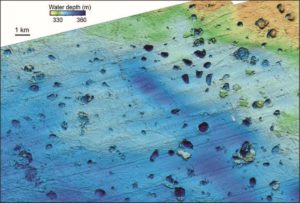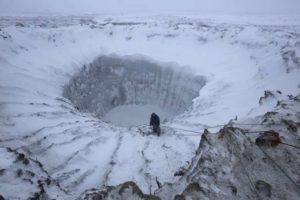Giant Craters Discovered on Arctic Ocean Floor : A Well Thought Out Scream by James Riordan

You’ve no doubt heard about the meth epidemic. While fast paling in comparison to the killer opiate epidemic sweeping America, we’ve all seen enough pictures of toothless hillbillies arrest for stealing fertilizer (yes, that’s what I said), to know that meth is bad. Turns out the Arctic Ocean is having its own share of meth problems. A study published in the latest edition of the journal Science says that during the last ice age, a sheet of ice up to two kilometres thick lay on the floor of the Barents Sea off Norway, holding vast amounts of methane in hydrate form — an ice-like mix of gas and water. Giant craters on the Arctic sea floor were formed when methane gas previously trapped in ice was released with such force it blew through bedrock, Norwegian researchers say.
According to the researchers, when a warming climate caused the ice sheet to dissipate around 12,000 years ago, the methane concentrated in mounds and then was “abruptly released,” causing the craters. “To disturb the bedrock that much, we feel pretty certain that it’s not something that can be done by gas bubbles just seeping up. It must have been a catastrophic event,” said lead author Karin Andreassen, a professor at the Centre for Arctic Gas Hydrate, Environment and Climate at the Arctic University of Norway.
 When Karin Andreassen set out for the Barents Sea, she knew she would find a lot of methane. The cold, shallow body of water just north of Norway meets Russia is home to oil and gas fields, and methane—the main component of natural gas—naturally seeps out of the seafloor here. Andreassen, a marine geologist at UiT The Arctic University of Norway, also knew from surveys in the 90s that she’d find some underwater craters.
When Karin Andreassen set out for the Barents Sea, she knew she would find a lot of methane. The cold, shallow body of water just north of Norway meets Russia is home to oil and gas fields, and methane—the main component of natural gas—naturally seeps out of the seafloor here. Andreassen, a marine geologist at UiT The Arctic University of Norway, also knew from surveys in the 90s that she’d find some underwater craters.
But she did not expect to find so many craters (hundreds!) and so many huge ones (half a mile wide). “They were giant,” she says, “And they were next to these huge mounds.” The mounds ended up being a clue to the craters’ origins. In a new study, Andreassen and her colleagues lay out a unified theory for how the craters and mounds formed as the Barents Sea itself changed over thousands of years. It all goes back to methane.
Methane can form deep underground, where heat and pressure transform ancient organic material into methane gas. Fifteen thousand years ago during the Ice Age, when the Barents Sea was not yet a sea but an ice sheet, methane that migrated up through bedrock would have hit solid ice. It couldn’t go anywhere so it froze in place as methane hydrate. But as ice sheets melted to form a now liquid Barents Sea, the hydrates also began to turn back into methane gas. Pressure from this gas lifted the seafloor to create the giant mounds. With enough pressure, the mounds could blow, creating those giant craters.
Andreassen looked at the Barents Sea, but the same thing may have happened in other places when ice sheets retreated at the end of the Ice Age. Scientists have also found pingos in the Beaufort Sea north of Alaska and craters in the North Sea west of Norway.
 Like the craters observed in the Norwegian study, there are “pockmarks” that are actively releasing gas in areas of the Beaufort Sea, which stretches across the coasts of the Northwest Territories and Yukon Territory, Dallimore said.
Like the craters observed in the Norwegian study, there are “pockmarks” that are actively releasing gas in areas of the Beaufort Sea, which stretches across the coasts of the Northwest Territories and Yukon Territory, Dallimore said.
But unlike the “blowout” the Norwegian researchers believe formed the craters in the Barents Sea, the Beaufort Sea pockmarks developed with a slower release of gas that weakened the sediments on the sea floor, Dallimore said. Ancient methane ‘burp’ points to climate change 110 million years ago
And something similar may also be happening on land. In 2014, a number of huge craters appeared in Siberian. It was one of the hottest years on record in Siberia, and permafrost was melting. The craters were also found in areas rich in natural gas, and satellite imagery revealed mounds along with more craters. Russian scientists found clods of dirt that looked like they had been thrown from the craters. Irina Streletskaya, a geographer at Lomonosov Moscow State University who studied one of the craters, wrote in an email that she thinks trapped methane explains both the Barents Sea and Siberian craters.
New craters may be forming in the Barents Sea today, too. The smaller craters, says Andreassen, maybe the younger ones. But the bigger potential threat to climate change is not small methane blow-outs in the Barents Sea; it’s massive blow-outs that could happen in areas currently covered by ice. If ice sheets keep retreating in places like Greenland and Antarctica, it could leave more land bare and release long pent-up reservoirs of methane.
Methane continues to seep out into the water to this day, Andreassen said, through more than 600 “gas flares” that remain near the craters.
Methane gas in northern waters is also an issue in Canada, Scott Dallimore, a research scientist at the Geological Survey of Canada, told CBC News.
Scientists studying the release of gas into the ocean agree it has critical environmental implications.
“It adds on to the acidification of the ocean and changing of the chemistry of the ocean and the ecosystems of the ocean,” Andreassen said.
Whether the phenomenon also pushes greenhouse gases out of the water and into the atmosphere is an area requiring further research, the Norwegian study says. Are there really 7,000 Siberian methane bubbles ready to explode? At this point, it doesn’t appear the methane rising from the floor of the Barents Sea is reaching the air, Andreassen said.
That could be due to the depth of the Barents Sea, Dallimore said, because when methane is released as a gas, the bubbles rapidly dissolve into the ocean. The deeper the water, the further the bubbles have to travel, so the methane is more likely to dissolve by the time it reaches the surface. But the Beaufort Sea shelf is more shallow, he said, so it’s possible for methane bubbles to reach the atmosphere.
“It’s a topical concern,” Dallimore said, noting that there is a program that assesses these types of potential “geohazards” in Canada, but more study is needed.
This study adds to existing uncertainty about the behavior of methane trapped near the poles. Methane is worrying because it can have an accelerating effect: As ice and permafrost melt, they release more methane, a powerful greenhouse gas, which makes the Earth warmer, so more ice melts, and more methane is released and so on. Scientists have mostly studied the gradual and continual seeping of methane in places like the Barents Sea. In those cases, microbes in the water use up the methane before it reaches the atmosphere, so it’s not a huge concern. But how much methane is being released in these blow outs, and does it work any differently? Carolyn Ruppel, who studies gas hydrates at the U.S. Geological Survey, poses the question this way, “If you’ve got a huge burp of methane, can that methane get to the sea-air interference before it can be destroyed by microbes in water column?”
The answer will likely lie in ice cores taken about 12,000 years ago, when the Barents Sea ice sheet melted. If the retreating ice sheet really did release a burst of methane into the atmosphere, you’d find it in the ice cores. Andreassen says they are now looking into such a study. And if polar ice keeps melting, well, we’ll eventually see if the consequences for ourselves. So, just another concern to add to your worry sheet.
___




No Comment